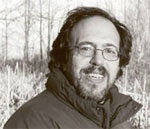LEE SMOLIN is a founding and senior faculty member at Perimeter Institute for Theoretical Physics in Waterloo, Canada. He is also Adjunct Professor of Physics at the University of Waterloo and is a member of the graduate faculty of the Department of Philosophy of the University of Toronto. His is the author od Time Reborn: From the Crisis in Physics to the Future of the Universe.
BRAIDS
BRAIDS
Theoretical physicists working in the rarefied field of loop quantum gravity have developed a way to describe elementary particles as merely tangles in space. If they are right, it could be the most profound scientific generalisation of all time, in which everything in the universe emerges from a simple network of relationships, with no fundamental building blocks at all. — New Scientist, Editorial [12 August 06]

About a decade ago, in my book The Third Culture (1995), Lee Smolin's chapter ("A Theory of the Whole Universe") began with the following comments:
"What is space and what is time? This is what the problem of quantum gravity is about. In general relativity, Einstein gave us not only a theory of gravity but a theory of what space and time are — a theory that overthrew the previous Newtonian conception of space and time. The problem of quantum gravity is how to combine the understanding of space and time we have from relativity theory with the quantum theory, which also tells us something essential and deep about nature. If we can do this, we'll discover a single unified theory of physics that will apply to all phenomena, from the very smallest scales to the universe itself. This theory will, we're quite sure, require us to conceive of space and time in new ways that take us beyond even what relativity theory has taught us.
"But, beyond even this, a quantum theory of gravity must be a theory of cosmology. As such, it must also tell us how to describe the whole universe from the point of view of observers who live in it — for by definition there are no observers outside the universe. This leads directly to the main issues we're now struggling with, because it seems very difficult to understand how quantum theory could be extended from a description of atoms and molecules to a theory of the whole universe. As Bohr and Heisenberg taught us, quantum theory seems to make sense only when it's understood to be the description of something small and isolated from its observer — the observer is outside of it. For this reason, the merging of quantum theory and relativity into a single theory must also affect our understanding of the quantum theory. More generally, to solve the problem of quantum gravity we'll have to invent a good answer to the question: How can we, as observers who live inside the universe, construct a complete and objective description of it?"
Discover Magazine had run a cover story proclaiming Smolin "The New Einstein". It may have impressed the general reader, but not mainstream physicists. As cosmologist Alan Guth, father of the inflationary theory of the Universe, noted in The Third Culture:
"The relativity physicists belong to a small club. It's a club that has yet to convince the majority of the community that the approach they're pursuing is the right one. Certainly Smolin is welcome to come and give seminars, and at major conferences he and his colleagues are invited to speak. The physics community is interested in hearing what they have to say. But the majority looks to the superstring approach to answer essentially the same questions."
Also weighing in was particle physicist and Nobel Laureate Murray Gell-Mann:
"Smolin? Oh, is he that young guy with those crazy ideas? He may not be wrong!"
A decade later, Smolin's ideas are beginning to get traction.New Scientist has published a cover story [12 August 06] reporting on the work on "Braids" and Loop Quantum Gravity by Smolin, Carlo Rovelli, Sundance Bilson-Thompson, and Fotini Markopoulou. An accompanying editorial proclaims that "it could be the most profound scientific generalisation of all time."
Is it time to overthrow decades of work on string theory? The jury is out on the ideas generated by Smolin and his colleagues, but the question is now being asked by more than a few physicists.
—JB

